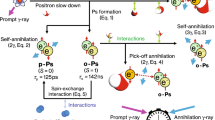Abstract
Current trends in development of positron annihilation tomography (change-over to total body tomography, new image reconstruction methods based on Time-of-Flight techniques and 3γ annihilation events) are discussed. They open up unique possibilities of identifying both the annihilation point of Ps atoms and their lifetime in the tissues of the organism under study (Ps imaging). Our experimental data are presented that demonstrate a relationship between the Ps lifetime and the degree of oxygenation of tissues, which is actually a new additional method for tumor diagnostics using е+е– annihilation.




Similar content being viewed by others
REFERENCES
C. S. Levin, “Primer on molecular imaging technology,” Eur. J. Nucl. Med. Mol. Imaging. 32, S325–S345 (2005). https://doi.org/10.1007/s00259-005-1973-y
S. S. Gambhir, “Molecular imaging of cancer with positron emission tomography,” Nat. Rev. Cancer. 2, 683–693 (2002). https://doi.org/10.1038/nrc882
P. Moskal and E. Ł. Stępień, “Prospects and clinical perspectives of total-body PET imaging using plastic scintillators,” PET Clin. 15 (4), 439–452 (2020). https://doi.org/10.1016/j.cpet.2020.06.009
R. D. Badawi, H. Shi, P. Hu, S. Chen, T. Xu, P. M. Price, Y. Ding, B. A. Spencer, L. Nardo, W. Liu, J. Bao, T. Jones, H. Li, and S. R. Cherry, “First human imaging studies with the EXPLORER total-body PET scanner,” J. Nucl. Med. 60 (3), 299–303 (2019). https://doi.org/10.2967/jnumed.119.226498
S. R. Cherry, R. D. Badawi, J. S. Karp, W. W. Moses, P. Price, and T. Jones, “Total-body imaging: Transforming the role of positron emission tomography,” Sci. Trans. Med. 9 (381), eaaf6169 (2017). https://doi.org/10.1126/scitranslmed.aaf6169
S. R. Cherry, T. Jones, J. S. Karp, J. Qi, W. Moses, and R. D. Badawi, “Total-body pet: Maximizing sensitivity to create new opportunities for clinical research and patient care,” J. Nucl. Med. 59 (1), 3–12 (2017). https://doi.org/10.2967/jnumed.116.184028
A. Gajos, D. Kamińska, E. Czerwiński, D. Alfs, T. Bednarski, P. Białas, B. Głowacz, M. Gorgol, B. Jasińska, Ł. Kapłon, G. Korcyl, P. Kowalski, T. Kozik, W. Krzemień, E. Kubicz, M. Mohammed, Sz. Niedźwiecki, M. Pałka, M. Pawlik-Niedźwiecka, L. Raczyński, Z. Rudy, O. Rundel, N.G. Sharma, M. Silarski, A. Słomski, A. Strzelecki, A. Wieczorek, W. Wiślicki, B. Zgardzińska, M. Zieliński, and P. Moskal, “Trilateration-based reconstruction of ortho-positronium decays into three photons with the J-PET detector”, Nucl. Instrum. Methods Phys. Res., Sect. A. 819, 54–59 (2016). https://doi.org/10.1016/j.nima.2016.02.069
K. Kacperski, N. M. Spyrou, and F. A. Smith, “Three-gamma annihilation imaging in positron emission tomography,” IEEE Trans. Med. Imaging. 23 (4), 525–529 (2004). https://doi.org/10.1109/TMI.2004.824150
S. Niedźwiecki, P. Białas, C. Curceanu, E. Czerwiński, K. Dulski, A. Gajos, B. Głowacz, M. Gorgol, B. C. Hiesmayr, B. Jasińska, L. Kapłon, D. Kisielewska-Kamińskaa, G. Korcyl, P. Kowalski, T. Kozik, N. Krawczyk, W. Krzemień, E. Kubicz, M. Mohammed, M. Pawlik-Niedźwiecka, M. Palka, L. Raczyński, Z. Rudy, N. G. Sharma, S. Sharma, R. Y. Shopa, M. Silarski, M. Skurzok, A. Wieczorek, W. Wiślicki, B. Zgardzińska, M. Zieliński, and P. Moskal, “J-PET: A new technology for the whole-body PET imaging,” Acta Phys. Pol., B. 48 (10), 1567–1576 (2017). https://doi.org/10.5506/APhysPolB.48.1567
P. Moskal, B. Jasińska, E. Ł. Stępień, and S. D. Bass, “Positronium in medicine and biology,” Nat. Rev. Phys. 1, 527–529 (2019). https://doi.org/10.1038/s42254-019-0078-7
A. Carreau, B. El Hafny-Rahbi, A. Matejuk, C. Grillon, and C. Kieda, “Why is the partial oxygen pressure of human tissues a crucial parameter? Small molecules and hypoxia,” J. Cell. Mol. Med. 15 (6), 1239–1253 (2011). https://doi.org/10.1111/j.1582-4934.2011.01258.x
B. Jasińska, B. Zgardzińska, G. Chołubek, M. Gorgol, K. Wiktor, K. Wysoglad, P. Białas, C. Curceanu, E. Czerwiński, K. Dulski, A. Gajos, B. Głowacz, B. Hiesmayr, B. Jodłowska-Jędrych, D. Kamińska, G. Korcyl, P. Kowalski, T. Kozik, N. Krawczyk, W. Krzemień, E. Kubicz, M. Mohammed, M. Pawlik-Niedźwiecka, S. Niedźwiecki, M. Pałka, L. Raczyński, Z. Rudy, N.G. Sharma, S. Sharma, R. Shopa, M. Silarski, M. Skurzok, A. Wieczorek, H. Wiktor, W. Wiślicki, M. Zieliński, and P. Moskal, “Human tissues investigation using PALS technique,” Acta Phys. Pol., B. 48 (10), 1737–1747 (2017). https://doi.org/10.5506/APhysPolB.48.1737
Z. Bura, K. Dulski, E. Kubicz, P. Małczak, M. Pędziwiatr, M. Szczepanek, E. Ł. Stępień, and P. Moskal, “Studies of the ortho-positronium lifetime for cancer diagnostics,” Acta Phys. Pol., B. 51 (1), 377–382 (2020). https://doi.org/10.5506/APhysPolB.51.377
P. S. Stepanov, F. A. Selim, S. V. Stepanov, A. V. Bokov, O. V. Ilyukhina, G. Duplâtre, and V. M. Byakov, “Interaction of positronium with dissolved oxygen in liquids,” Phys. Chem. Chem. Phys. 22 (9), 5123–5131 (2020). https://doi.org/10.1039/C9CP06105C
H. L. Clever, R. Battino, H. Miyamoto, Yu. Yampolski, and C. L. Young, “IUPAC-NIST solubility data series. Oxygen and ozone in water, aqueous solutions, and organic liquids (Supplement to Solubility Data Series Volume 7),” J. Phys. Chem. Ref. Data. 43 (3), 033102 (2014). https://doi.org/10.1063/1.4883876
R. Battino, T. R. Rettich, and T. Tominaga, “The solubility of oxygen and ozone in liquids,” J. Phys. Chem. Ref. Data. 12 (2), 163–178 (1983). https://doi.org/10.1063/1.555680
K. Shibuya, H. Saito, F. Nishikido, M. Takahashi, and T. Yamaya, “Oxygen sensing ability of positronium atom for tumor hypoxia imaging,” Commun. Phys. 3, 173 (2020). https://doi.org/10.1038/s42005-020-00440-z
ACKNOWLEDGMENTS
The experimental work was done at facilities of the Research Equipment Sharing Center KAMIKS (http://kamiks.itep.ru/), ITEP, NRC “Kurchatov Institute”.
Funding
The work was supported by the Russian Foundation for Basic Research, project no. 20-14-50150\20.
Author information
Authors and Affiliations
Corresponding author
Additional information
Translated by M. Potapov
About this article
Cite this article
Stepanov, S.V., Byakov, V.M. & Stepanov, P.S. Positronium in Biosystems and Medicine: A New Approach to Tumor Diagnostics Based on Correlation between Oxygenation of Tissues and Lifetime of the Positronium Atom. Phys. Wave Phen. 29, 174–179 (2021). https://doi.org/10.3103/S1541308X21020138
Received:
Revised:
Accepted:
Published:
Issue Date:
DOI: https://doi.org/10.3103/S1541308X21020138




